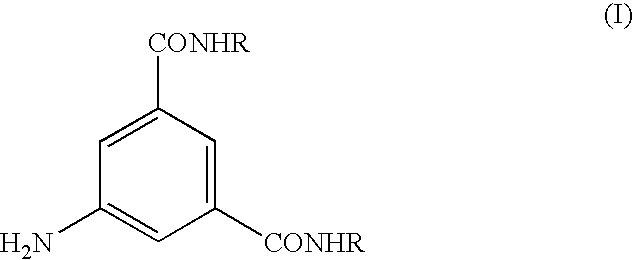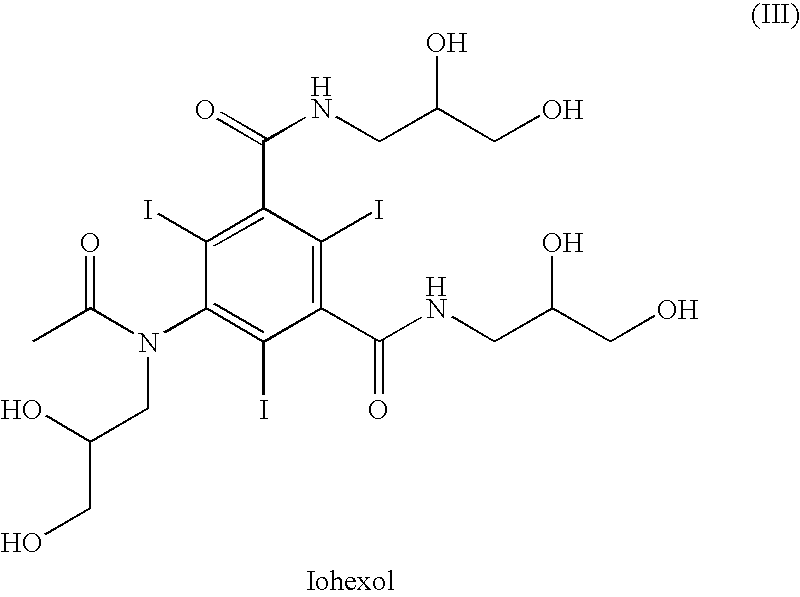Process for the preparation of N,N-substituted 5-amino-1,3-benzenedicarboxamides
a technology of benzenecarboxamide and substituted 5amino-1,3-benzenecarboxamide, which is applied in the preparation of carboxylic acid amides, amino-carboxyl compound preparations, organic chemistry, etc., can solve the problems of limiting the choice of reaction conditions, affecting the yield theoretically obtainable in the overall process, and compound stability at high temperatures
- Summary
- Abstract
- Description
- Claims
- Application Information
AI Technical Summary
Benefits of technology
Problems solved by technology
Method used
Image
Examples
example 2
5-amino-N,N′-bis[2-hydroxy-1-(hydroxymethyl)ethyl]-1,3-benzenedicarboxamide
[0061]2-Amino-1,3-dihydroxypropane (27.4 g, 300 mmol) and 1.5M solution of sodium methylate in methanol (14.3 mL, 21.5 mmol) are added to a suspension of 5-amino-1,3-benzenedicarboxylic acid dimethyl ester (30.0 g, 143 mmol) in methanol (0.2 L). The reaction mixture is heated to the reflux temperature to get a solution. After 2.5 hours of reflux and 4 hours at room temperature the reaction mixture is filtered and the solid on filter is washed with methanol (40 mL) and dried yielding the product of the title (43.5 g, 133 mmol, yield: 93%).
example 3
5-amino-N,N′-bis[2-hydroxy-1-(hydroxymethyl)ethyl]-1,3-benzenedicarboxamide
[0062]A mixture of 2-amino-1,3-dihydroxypropane (31 g, 340 mmol) and 5-amino-1,3-benzenedicarboxylic acid di-n-butyl ester (20.0 g, 68.2 mmol) is heated to 125° C. for 3 hours while the n-butyl alcohol which forms is distilled off. After cooling the reaction mixture to about 70° C. the solution is diluted with methanol (0.35 L) and a solid product crystallizes out. After 4 hours at room temperature the mixture is filtered and the solid on filter is washed with methanol (30 mL) and dried yielding the compound of the title (21.4 g, 65.5 mmol, yield: 96%).
example 4
5-amino-N,N′-bis[2-hydroxy-1-(hydroxymethyl)ethyl]-1,3-benzenedicarboxamide
[0063]5-Amino-1,3-benzenedicarboxylic acid di-n-butyl ester (1148 g, 3.91 mol) is loaded into a 10 L reaction vessel containing methanol (7.5 L) and a 1.5M solution of sodium methylate in methanol (0.39 L, 0.59 mol) and 2-amino-1,3-dihydroxypropane (820 g, 9.0 mol) are added thereto. The reaction mixture is then heated to the reflux temperature and kept at this temperature for 4 hours. The mixture is then concentrated to 4 L, cooled to 25° C. and after one night at room temperature it is filtered. The solid on filter is washed with methanol (2×1.3 L) and dried yielding the compound of the title (1215 g, 3.71 mol, yield: 95%).
PUM
| Property | Measurement | Unit |
|---|---|---|
| temperature | aaaaa | aaaaa |
| temperature | aaaaa | aaaaa |
| temperature | aaaaa | aaaaa |
Abstract
Description
Claims
Application Information
 Login to View More
Login to View More - R&D
- Intellectual Property
- Life Sciences
- Materials
- Tech Scout
- Unparalleled Data Quality
- Higher Quality Content
- 60% Fewer Hallucinations
Browse by: Latest US Patents, China's latest patents, Technical Efficacy Thesaurus, Application Domain, Technology Topic, Popular Technical Reports.
© 2025 PatSnap. All rights reserved.Legal|Privacy policy|Modern Slavery Act Transparency Statement|Sitemap|About US| Contact US: help@patsnap.com



